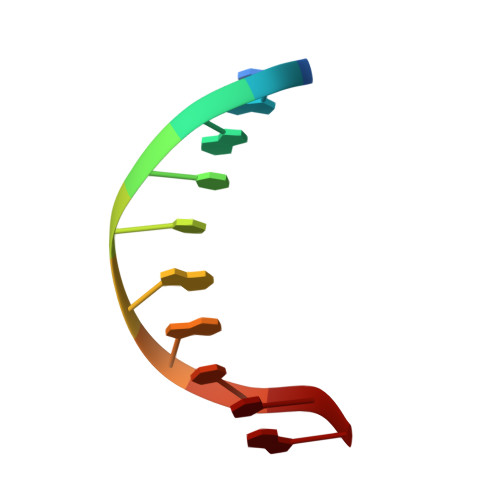The structure of B-helical C-G-A-T-C-G-A-T-C-G and comparison with C-C-A-A-C-G-T-T-G-G. The effect of base pair reversals.
Grzeskowiak, K., Yanagi, K., Prive, G.G., Dickerson, R.E.(1991) J Biol Chem 266: 8861-8883
- PubMed: 2026600
- DOI: https://doi.org/10.2210/pdb1d23/pdb
- Primary Citation of Related Structures:
1D23 - PubMed Abstract:
The crystal structure of the DNA decamer C-G-A-T-C-G-A-T-C-G has been solved to a resolution of 1.5 A, with a final R-factor of 16.1% for 5,107 two-sigma reflections. Crystals are orthorhombic space group P2(1)2(1)2(1), with cell dimensions a = 38.93 A, b = 39.63 A, c = 33.30 A, and 10 base pairs/asymmetric unit. The final structure contains 404 DNA atoms, 142 water molecules treated as oxygen atoms, and two Mg(H2O)6(2+) complexes. Decamers stack atop one another to simulate continuous helical columns through the crystal, as with three previously solved monoclinic decamers, but the lateral contacts between columns are quite different in the orthorhombic and monoclinic cells. Narrow and wide regions of the minor groove exhibit a single spine or two ribbons of hydration, respectively, and the minor groove is widest when BII phosphate conformations are opposed diagonally across the groove. Phosphate conformation, in turn, appears to have a base sequence dependence. Twist, rise, cup, and roll are linked as has been observed in the three monoclinic decamers and can be characterized by high or low twist profiles. In all five known decamer crystal structures and eight representative dodecamers, a high twist profile is observed with G-C and G-A steps whereas all other R-R steps are low twist profiles (R = purine). A-T and A-C steps are intermediate in character whereas C-A and C-G exhibit behavior that is strongly influenced by the profiles of the preceding and following steps. When sufficient data are in hand, sequence/structure relationships for all helix parameters probably should be considered in a 4-base pair context. At this stage of limited information the problem is compounded because there are 136 unique 4-base steps x-A-B-y in a double helix as compared with only 10 2-base steps A-B.
Organizational Affiliation:
Department of Chemistry and Biochemistry, University of California, Los Angeles 90024.















